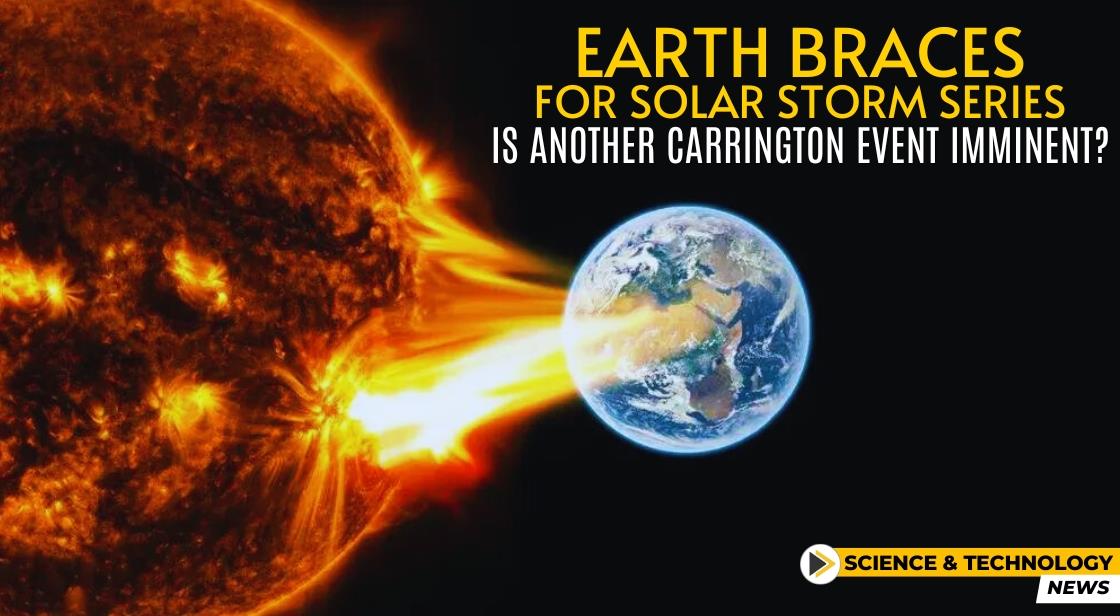Earth Braces for Solar Storm Series: Is Another Carrington Event Imminent?

News Synopsis
The Sun's fiery temper tantrums are no secret. In 1859, the Carrington Event sent shockwaves through our planet, disrupting telegraph systems and showcasing the immense power of solar storms. Now, history might be echoing as Earth prepares for a series of powerful coronal mass ejections (CMEs) launched by the colossal sunspot AR3664.
A "Carrington-Class" Sunspot Unleashes CMEs
This behemoth sunspot, designated "Carrington-class" due to its potential for significant impact, has already unleashed a barrage of five CMEs towards Earth. These solar eruptions, carrying magnetized plasma, can trigger geomagnetic storms upon reaching our planet, causing disruptions to power grids, communication systems, and even producing dazzling auroral displays.
The Cannibal CME: A Merging Menace
Adding another layer of concern, forecasts from NOAA (National Oceanic and Atmospheric Administration) suggest that the first three CMEs might combine to form a monstrous "Cannibal CME." This phenomenon occurs when faster-moving CMEs overtake and absorb slower ones, creating intensified shock waves within the merged mass. Upon impact with Earth's magnetic field, these supercharged CMEs can trigger powerful geomagnetic storms.
When Will the Cannibal CME Arrive?
The Cannibal CME is expected to arrive on May 11th, packing the potential to unleash a strong (G3) geomagnetic storm. However, with two additional CMEs trailing close behind, the storm intensity could escalate to extreme (G4) levels. Such a scenario could ignite auroras visible even at mid-latitudes across Europe and the United States, offering a spectacular light show alongside the potential disruptions.
A "Solar Storm Train" Heads Towards Earth
Dr. Tamitha Skov, a leading space weather expert, aptly describes the situation as a "solar storm train," highlighting the multiple storms heading towards our planet. Her observations suggest direct hits from Storms 2, 3, and 5, with impacts starting around midday on May 10th and potentially continuing through May 12th. Dr. Skov warns of potential G3-level geomagnetic storm conditions and extended auroral displays.
NOAA's Geomagnetic Storm Forecast
The National Oceanic and Atmospheric Administration (NOAA) has issued a geomagnetic storm forecast for May 10th-12th. Here's a breakdown of their predictions:
-
May 10-12: G1-2 (Minor-Moderate) geomagnetic storming due to initial CMEs from AR 3634.
-
May 11: Potential for G3 (Strong) to G4 (Severe or greater) geomagnetic storming as the bulk of the CME activity arrives.
While the exact impact remains uncertain, NOAA also warns of the possibility of R3 (Strong or greater) radio blackouts due to isolated X-class flare activity. These blackouts are primarily a concern during the active period of sunspot AR 3634, spanning May 8th-9th.
Beyond geomagnetic disturbances, NOAA also forecasts the possibility of R3 (Strong or greater) radio blackouts. These disruptions are likely due to isolated X-class flare activity, potentially originating from the active sunspot AR 3634.
What to Expect?
The potential consequences of these solar storms vary depending on the intensity of the geomagnetic activity. Here's a possible scenario:
-
Auroras: G3-G4 storms could trigger spectacular auroras visible at much lower latitudes than usual, potentially reaching areas like Europe and the United States.
-
Power Grid Disruptions: Strong geomagnetic storms can induce harmful currents in power grids, leading to potential outages and infrastructure damage.
-
Communication Issues: Radio blackouts caused by solar flares can disrupt communication systems relying on high-frequency radio waves.
Conclusion:
As Earth braces for the incoming solar storm series, reminiscent of the Carrington Event, vigilance and preparedness are paramount. With forecasts indicating potential geomagnetic disturbances and auroral spectacles, scientists and enthusiasts alike are monitoring the skies with anticipation and caution.









